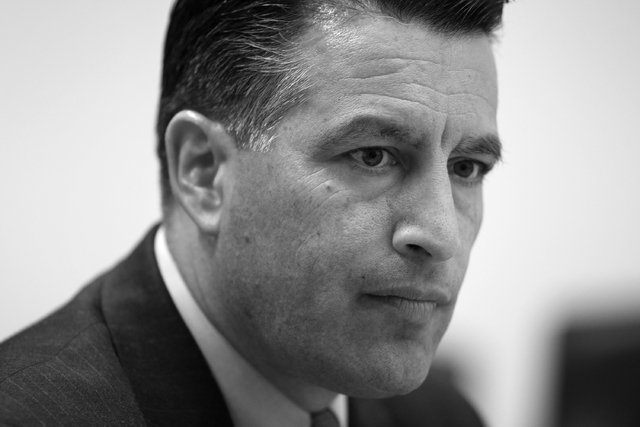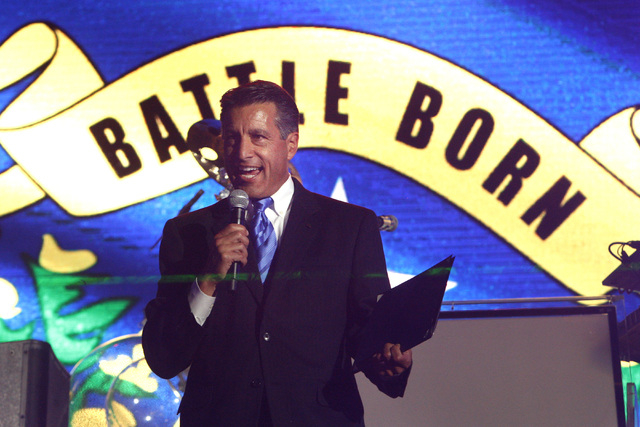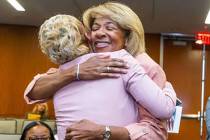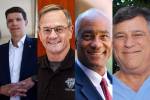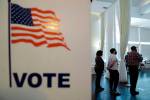Will Sandoval’s inaugural address be as ‘optimistic’ this time around?
When Gov. Brian Sandoval delivered his first inaugural address four years ago, he made a prediction:
“By 2014, we will emerge with a smaller, more efficient state government, an education system we can be proud of, and a supply of good jobs transformed by a forever-changed economy,” he said in an upbeat speech in light of Nevada’s status as the state hardest hit by the recession.
Sandoval peppered his 12-minute address on the steps of the Capitol in Carson City with the words “optimism” or “optimistic” nine times. And he mentioned “opportunity” for growth, progress and prosperity 13 times, promising he would lead Nevada out of its financial doldrums.
“The Nevada of my youth was a place of pride, activity, optimism, and opportunity,” Sandoval said, noting the state’s upcoming 150th birthday, in 2014. “This has long been our state’s heritage. And it must be our future as well.”
On Monday, Sandoval will launch his second, four-year term with another pivotal inaugural address as he and his fellow Republicans take control of all state constitutional offices and both houses of the Legislature for the first time since 1929.
Sandoval, a former federal judge, attorney general and Nevada’s first Hispanic governor, is opening a new chapter in his political career as well that could carry him to Washington, D.C. — Congress, the Cabinet or even the Oval Office as his national reputation grows.
The outcome of this year’s biennial session of the Nevada Legislature will be telling as Sandoval works to seal his legacy as either a governor who reformed education and the tax system while transforming Nevada’s tourism-based economy, or as a promising politician with a limited record of success.
As a result, 2015 will be a key year in Nevada politics, which is also setting the stage for the election of a new president and the likely run of U.S. Sen. Harry Reid, D-Nev., for a sixth Senate term.
“Harry Reid being on the ticket is going to change the election completely,” Nick Phillips, the political director of the Clark County Republican Party, said of 2016, when he expects the Nevada Democratic Party to compete more robustly than it did in 2014. “You’re going to have a ton more people out for the presidential race, too.”
The winners of those key races in Nevada — an early voting battleground state after Iowa and New Hampshire — will determine the direction of Nevada and the nation for some time to come.
SANDOVAL’S LEGACY
For Sandoval, the question is whether he can use his popularity and political mandate after winning more than 70 percent of the 2014 vote to achieve his goals.
On Sandoval’s watch Nevada has begun to emerge from the recession, enjoying the nation’s third-highest job growth rate — 3.7 percent — in the first half of 2014, behind North Dakota and Colorado.
Nevada’s unemployment rate has steadily dropped to 6.9 percent, about half the nearly 14 percent rate when Sandoval took office in January 2011.
Sandoval has clearly delivered on the jobs growth aspect of his 2011 goals with nearly 100,000 private-sector jobs created so far — twice what he promised.
Delivering on economic diversification, he recently inked a major deal with the electric car company Tesla to build a $5 billion battery factory near Reno and hire 6,500 workers in exchange for unprecedented tax breaks. Nevada is also one of six states the federal government picked as a drone test and development hub, a coup for the vast desert state.
In other areas, Sandoval has yet to fully deliver.
The effort is lagging to improve Nevada’s education system — still one of the least effective in the nation — and trim government in the face of ever-expanding Medicaid rolls and K-12 student populations overcrowding schools.
Sandoval has said he will put a premium on education reform in the biennial budget he’ll present Jan. 15 when he delivers his State of the State address. The Nevada Legislature begins its 120-day session on Feb. 2.
And he’s pushing for tax reform in light of growing revenue needs and an anemic $6.3 billion in expected tax collections in the coming two budget years — or about $400 million less than the current biennial spending plan.
Sandoval may well win on education reform, mostly because GOP majorities in the Legislature share his goals of increasing competition by expanding charter schools and choice options, but most of the incoming crop of Assembly Republicans have pledged opposition to new taxes, and a two-thirds vote in the state Senate and Assembly is needed to approve taxes.
Sandoval should have little trouble meeting that vote threshold in the state Senate, where Republicans hold a slim 11-10 seat advantage over Democrats. Majority Leader Michael Roberson, R-Las Vegas, has said he’s taking his cues from Sandoval and most — if not all — of the Democrats would likely support tax reform that adds money for education.
The Assembly will be another matter, with at least 28 votes out of 42 members needed to approve taxes. That means 15 Republicans could block any tax proposal — something that occurred in 2003, the last time a GOP governor, Kenny Guinn, proposed a major tax hike of $1 billion for education and other needs. In the end, Guinn’s proposal failed after two special sessions and a court battle, something Sandoval hopes to avoid.
Phillips, the Clark County GOP political director, said conservative members of the Assembly “don’t want anything shoved down their throats,” but could be persuaded to adopt some tax reforms in exchange for education reform and zero-based budgeting, which means there would be no automatic growth in state programs.
Sandoval is already meeting with legislative leaders behind the scenes to coax compromise along.
“A lot of it depends on the State of the State (address) Jan. 15,” Phillips said. “If he says, ‘It’s this way no matter what,’ it will give credence to those who say he’s trying to shove something down their throats.”
But that’s not Sandoval’s style. Instead, he prefers to get all parties at the table and negotiate.
“If Sandoval will do that, it will take some of the wind out of the sails of the craziness,” Phillips said.
TAX FIGHT PREDICTED
At 51, Sandoval appears motivated mostly by a desire to make his mark in Nevada history as the state’s 29th governor. One of his closest mentors is former Nevada Gov. and U.S. Sen. Paul Laxalt, a moderate known for his soft style and love of the Silver State. In his day, Laxalt, too, was mentioned as a possible White House prospect.
Personal ambition plays a role, as well. This year, Sandoval is chairman of the Western Governors’ Association, giving him a larger platform for his ideas on issues ranging from drought to clean energy development, where Nevada is a leader.
Sandoval’s biggest challenge might come from within his own party, in the form of the dysfunctional Assembly Republican Caucus now engaged in a power struggle between conservative and moderate factions.
For the moment, a Sandoval ally, Assembly Speaker-designee John Hambrick, R-Las Vegas, is leading the caucus. But the group of mostly conservative freshmen who won on anti-tax campaigns might depose him and might defy attempts by the governor to negotiate any tax reform that is not revenue neutral.
A Republican close to Sandoval predicted the governor will find a way to work with Assembly naysayers.
“I think the Assembly GOP will have some comical moments, but also believe they will have the votes to pass real, positive legislation,” said the Republican, who spoke on condition of anonymity. “That said, they are back in the minority next session. It’s a numbers game and it just won’t hold in a presidential year.”
Indeed, the Assembly may well revert to Democratic control after the 2016 elections, given an expected higher voter turnout with the White House race and Reid on the ballot. Democrats have some 63,000 more registered voters statewide than Republicans, a gap that could grow if Democrats hold a successful registration drive this year.
SENATOR SANDOVAL?
Besides trying to cement his legacy, the other big question for Sandoval is what does he do next.
Republicans, including Sandoval’s close colleague, U.S. Sen. Dean Heller, R-Nev., want him to run against Reid.
“We will see what he wants to do,” Heller said in November. “I’m not sure he’s made a decision up to this point. I’m not the only one having conversations with him. Others are too. We will give him a little bit of time to do that.”
Sandoval is considered the strongest contender against Reid, who has been Senate majority leader since January 2007. He lost his position in the Nov. 4 election after Republicans took control of the U.S. Senate. Reid will be the minority leader in the 114th Congress, which convenes on Tuesday.
But Sandoval repeatedly has insisted he has no interest in competing against Reid in 2016 and instead wants to finish his four-year term as governor in 2018. That doesn’t mean his arm can’t be twisted. After all, he gave up a lifetime appointment as a federal judge to run for governor against a GOP incumbent, Jim Gibbons. He cleaned Gibbons’ clock.
Also taking a pass, at least for now, are U.S. Reps. Joe Heck, R-Nev., and Mark Amodei, R-Nev., who have said publicly they don’t plan to run against Reid in 2016.
Las Vegas City Councilman Bob Beers, a Republican, has been quietly running against Reid since January 2014 after his supporters raised money to put out 55,000 pamphlets promoting him. A longtime political player, Beers has served in the Assembly and state Senate and ran for governor in 2006, finishing second in a five-way GOP primary.
“He has told me personally that he is not interested in running and best wishes,” Beer said of Sandoval, adding he had a similar conversation with Heck. “So I don’t know if we’ll have nearly a spirited primary as we had last time.”
In 2010, Republican Sharron Angle, a tea party conservative, won a crowded GOP primary after Reid’s campaign lambasted her competitors, focusing on former state Sen. Sue Lowden, who was considered the strongest GOP candidate. Reid chased Lowden from the race and ran against Angle in a scorched-earth campaign that ended her political career.
Beers said Reid’s best chance to win re-election is to pull the same stunt, working to help defeat the strongest Republican contenders in hope of facing the weakest GOP candidate in the general election. Reid, who is 20 years older than Beers, would be 78 when he begins his sixth term in 2017, if re-elected.
Other potential GOP contenders include outgoing Lt. Gov. Brian Krolicki, incoming Lt. Gov. Mark Hutchison, who Sandoval strongly supported as his No. 2, and state Sens. Michael Roberson, the Senate majority leader from Las Vegas, and Ben Kieckhefer, R-Reno, an up-and-comer in the Legislature.
Contact Laura Myers at lmyers@reviewjournal.com or 702-387-2919. Follow @lmyerslvrj on Twitter.
New year could bring big changes in state




